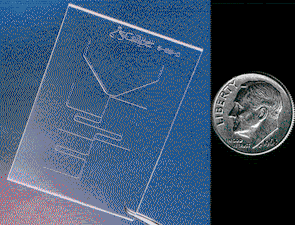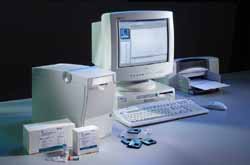HP Launches First Lab-on-a-Chip Product

Contents
Implications for Life Scientists
Initial Applications
Pricing and Availability
HP's Chemical Analysis Group becomes Agilent
For those wondering when microanalytical laboratories on a chip would be commercial, the answer is: Now. Hewlett-Packard's (Palo Alto, CA) HP 2100 bioanalyzer, which debuted on September 15, marks a milestone in the commercialization of lab-on-a-chip (LOC) technology. Consisting of a core analyzer chip (for nucleic acids) and supporting instrumentation, the 2100 is the first complete instrument based on the LOC idea.
Caliper Technologies' (Mountain View, CA) LabChip, the most advanced and best-supported LOC on the market, makes up the guts of the new analyzer. In the LabChip all sample preparation, fluid handling, and biochemical analysis are carried out within the confines of a microchip. Chips consist of interconnected networks of fluid reservoirs and pathways etched into glass, plastic or other substrates.

LabChip: "Caliper Technologies' LabChip"
LabChip uses microfabrication techniques borrowed from the semiconductor industry to build various chip architectures, such as interconnected fluid reservoirs and pathways. When used with experimental protocols developed in software, these chips comprise the heart of a nanoscale laboratory.
Fluids travel through the chip driven by electrodes that generate electrokinetic forces that drive fluids through selected pathways. The process is analogous to fluids driven by a voltage gradient in capillary electrophoresis. Fluid speed and direction is controlled by balancing and/or sequencing voltage inputs. This setup creates the equivalent of valves and pumps capable of such manipulations as reagent dispensing, mixing, incubation, reactions, and separations.
Shrinking the business end of a lab to chip size cuts system retention and material transfer losses, thereby improving accuracy while reducing sample consumption.
When used with various LabChip kits, the HP 2100 bioanalyzer improves the quality of nucleic acid analysis by integrating sample handling, separation, detection and digital data processing within a single, compact system architecture. The system is designed for use by molecular biologists and biochemists working with polymerase-chain-reaction (PCR) products, restriction enzyme digests or ribonucleic acid (RNA) preparations.
Implications for Life Scientists
Researchers in the areas of disease and drug discovery still experience manual processing bottlenecks during the analysis of nucleic acids. LabChip technology offers many benefits over existing manual gel electrophoresis products:
• Improved Accuracy – Integrated, miniaturized chip design drastically cuts system-retention and material-transfer losses, improving accuracy and reducing sample consumption.
• Rapid Analysis – miniaturized fluid pathways, based on microchannels microns in size, dramatically shorten run times. Each nucleic acid sample is analyzed in approximately 90 seconds.
• Enhanced Reproducibility – State-of-the-art fabrication yield chips that perform more reproducibly than conventional gel products. Automated fluid handling, using standardized experimental protocols, further enhances performance.

The HP 2100 bioanalyzer – the first complete analytical laboratory based on a LOC.
Initial Applications
The HP 2100 bioanalyzer is offered with three introductory assays. Each assay is packaged as a complete, ready-to-use kit:
• DNA 7500 LabChip kit for accurate sizing and quantitation of DNA fragments ranging in size from 100bp to 7,500bp
• DNA 12000 LabChip kit for accurate sizing of DNA fragments from 100bp to 12,000bp
• RNA 6000 LabChip kit for the analysis and quantitation of total RNA and mRNA samples.
Pricing and Availability
Initially available in the United States, Germany, the United Kingdom, and Switzerland, the HP 2100 bioanalyzer can be ordered directly through HP chemical-analysis-products sales offices in each of the selected countries. The price of the complete system is $18,800, and delivery is estimated at six weeks from receipt of order. The system is expected to be available in additional European countries and Japan within the next year.
HP's Chemical Analysis Group becomes Agilent
The HP 2100 is the kind of product we've come to expect from Hewlett Packard, but within several weeks the 2100, with the rest HP's Chemical Analysis products, will be owned by a spinoff, Agilent Technologies. With 42,000 employees worldwide, Agilent will begin life as one of the largest instrument companies in the world. It takes with it HP's chemical analysis, automated testing, communications solutions, electronic products, healthcare, and semiconductor divisions.
Agilent will start off as a subsidiary of HP in November, 1999, and become a completely independent company some time in 2000.
For more information: Kevin Meldrum, Product Marketing Manager, N/A, 1601 California Ave., Palo Alto, CA 94304. Tel: 650-236-5155.
By Angelo DePalma
